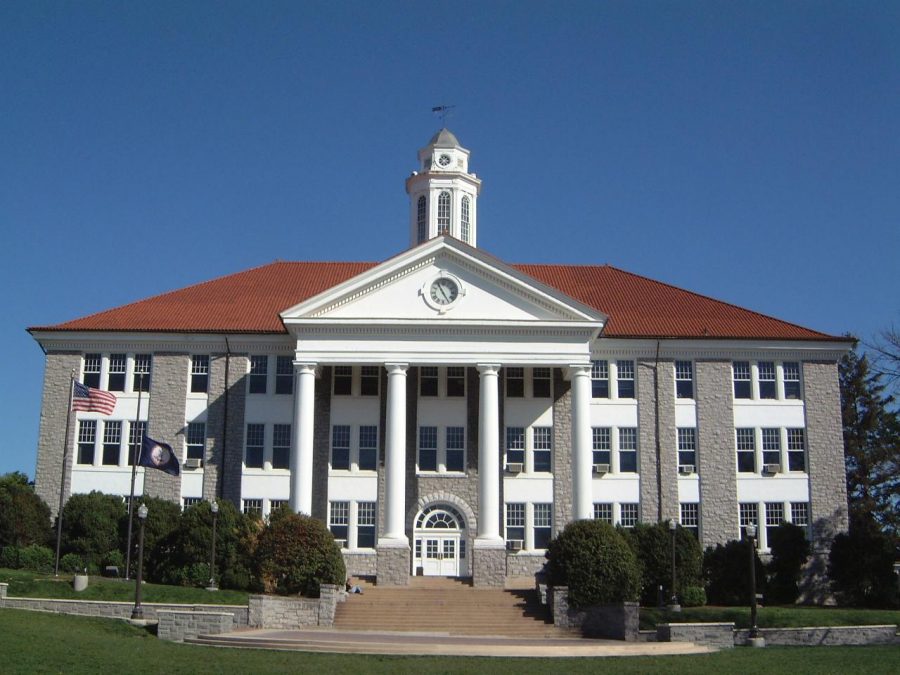Colleges send students home after surge in COVID-19 cases
After 500 students tested positive for COVID-19, James Madison University sent students home on Sept. 7. Wilson Hall is pictured above. (PHOTO COURTESTY OF WIKIMEDIA COMMONS)
November 5, 2020
Due to the rising number of students testing positive for COVID-19 on campuses in August, many U.S. colleges have sent students home in order to prevent further spread of the virus.
Many scientists have been debating whether sending college students home is actually safer than keeping them on campus for the past few months. According to The New York Times, 88,000 infections have resulted from colleges bringing students back to campus. Colleges are more likely to become hotspots for the disease because they are more densely populated, therefore students are more likely to come into contact with others.
At many universities across the country, when students arrived on campus, there were reports of students gathering in large groups and ignoring social distancing protocols. One week after the campus re-opened, students at the University of North Carolina at Chapel Hill were sent home after 13% of the student body tested positive for the coronavirus. An investigation conducted by the staff revealed that most of the cases were linked to large-group events hosted by sororities and fraternities that had not followed social distancing and mask policies. Similar incidents have occurred at Towson University, North Carolina State University, the University of Toledo and many more schools across the country, causing students to be sent home.
Dr. Anthony Fauci, the director of the National Institute of Allergy and Infectious Diseases, has recommended that colleges refrain from sending kids home.
“It’s the worst thing you could do, when you send them home, particularly when you’re dealing with a university where people come from multiple different locations, you could be seeding the different places with infection,” Dr. Fauci said in a statement.
The White House Coronavirus coordinator, Dr. Deborah Birx, agreed with Fauci’s statement.
“Sending these individuals back home in their asymptomatic state to spread the virus in their hometown or among their vulnerable households could really recreate what we experienced over the June time frame in the South, so I think every university president should have a plan for not only testing but caring for their students that need to isolate,” Dr. Birx said in a message to governors.
Students and parents have responded to decisions relating to closings with mixed reactions. James Madison University (JMU) sent their students home on Sept. 7 after 500 students tested positive for COVID-19. Since then, students have been participating in online learning from home. According to JMU’s student-run newspaper The Breeze, JMU students were “very upset” and “frustrated” with this news.
Kurt Jacoby, a JMU freshman, expressed his excitement about getting involved with the social life on campus in an interview with The Breeze. He planned to participate in sports, Greek life and clubs, but now “[Jacoby] can’t, because that’s taken away from me.”
On the other hand, some JMU students approve of the school’s decision to transition to online learning. According to The Breeze, Kriszten Szakal, a senior at JMU, felt that the university did not do an adequate job of instating safety measures. She also said that she “felt it was careless on JMU’s part to bring the student population back to Harrisonburg” when Harrisonburg already had 1,000 cases before the students even returned to campus.
Sophia Samantaroy, a freshman at the University of Rochester and Madison alumna, has been attending school online at home since the beginning of the semester. The university gave students the choice to do their learning completely online or do hybrid learning on campus. Although Samantaroy had originally planned to go back to campus, she chose to do the semester online.
“The state of New York had just placed restrictions on people coming from other states, the school is six hours away and it was safer at home because there is less of a risk of getting infected,” Samantaroy said.
The school has also placed more restrictions on campus life, so if she were to return to campus, most of her classes would be online.
“[It is] harder to interact with my professors and classmates,” Samantaroy said while talking about her experience doing online learning.
She plans to move on campus for the spring semester in February and feels “comfortable” about relocating after seeing how successfully the University of Rochester has handled the situation so far. In the meantime, Samantaroy is managing online school by “taking things into my own hands, staying engaged, asking my professors questions, turning on my camera and interacting with others as much as possible.”



